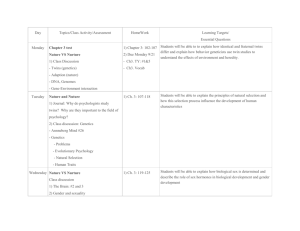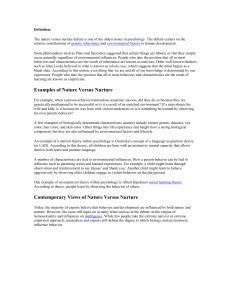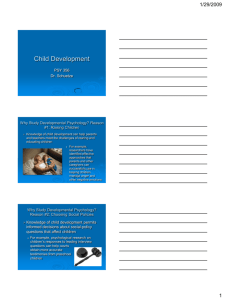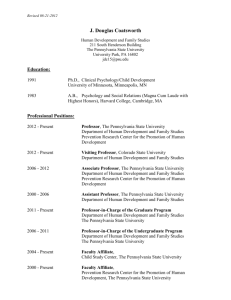Nature-Nurture - University of Minnesota Twin Cities
advertisement
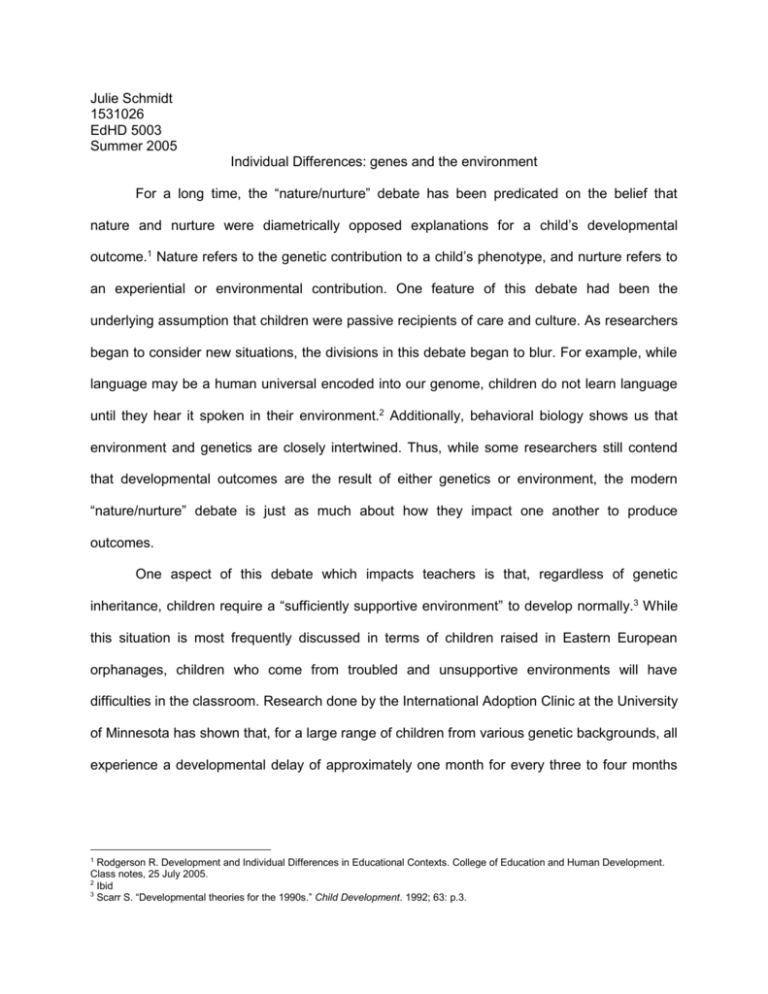
Julie Schmidt 1531026 EdHD 5003 Summer 2005 Individual Differences: genes and the environment For a long time, the “nature/nurture” debate has been predicated on the belief that nature and nurture were diametrically opposed explanations for a child’s developmental outcome.1 Nature refers to the genetic contribution to a child’s phenotype, and nurture refers to an experiential or environmental contribution. One feature of this debate had been the underlying assumption that children were passive recipients of care and culture. As researchers began to consider new situations, the divisions in this debate began to blur. For example, while language may be a human universal encoded into our genome, children do not learn language until they hear it spoken in their environment.2 Additionally, behavioral biology shows us that environment and genetics are closely intertwined. Thus, while some researchers still contend that developmental outcomes are the result of either genetics or environment, the modern “nature/nurture” debate is just as much about how they impact one another to produce outcomes. One aspect of this debate which impacts teachers is that, regardless of genetic inheritance, children require a “sufficiently supportive environment” to develop normally.3 While this situation is most frequently discussed in terms of children raised in Eastern European orphanages, children who come from troubled and unsupportive environments will have difficulties in the classroom. Research done by the International Adoption Clinic at the University of Minnesota has shown that, for a large range of children from various genetic backgrounds, all experience a developmental delay of approximately one month for every three to four months 1 Rodgerson R. Development and Individual Differences in Educational Contexts. College of Education and Human Development. Class notes, 25 July 2005. 2 Ibid 3 Scarr S. “Developmental theories for the 1990s.” Child Development. 1992; 63: p.3. they spend in an orphanage.4 This knowledge is also important because it instructs the teacher in an appropriate response, to provide a stimulating, supportive, and structured classroom to the greatest degree possible. This will in turn foster resilience, an adaptation to and ability to overcome environmental challenges, in those children with the innate capability to do so.5 Another important aspect to this debate is the question over the contribution of genetics and environment to learning disabilities. Plomin and DeFries give the example of dyslexia, which has a genetic component demonstrated by a higher correlation of identical twins both having the disorder compared to fraternal twins.6 There is also an environmental component demonstrated by the higher frequency of dyslexia observed in English-speaking countries and Italy, for example, where written words more consistently resemble the sound of those words.7 The classroom significance is that, for something which has long been considered a cognitive problem, and may contribute to frustration and poor self-esteem in a student, can be positively addressed by altering the environment. Enrolling these students in a foreign language, for example, where words match their sounds, may greatly enhance the student’s learning experience. In conclusion, it will be important in my classroom to remember that while developmental outcomes for children in sufficiently supportive environments are predictable, there are social and cognitive ways children can live outside of that range, and that there are ways that I, as a teacher, can structure my classroom and support that student to maximize their developmental outcomes. Bibliography Lofy L, & Dole K. “Internationally Adopted Children: Information for Parents and Educators.” Helping Children at Home and School II: Handouts for Families and Educators. S7-44 5 Masten AS, & Coatsworth JD. “The Development of competence in favorable and unfavorable environments.” American Psychologist. 1998; 53: 206, 212-3. 6 Plomin R, & DeFries JC. “The genetics of cognitive abilities and disabilities.” Scientific American. 1998; 278(5): 62-9. 7 Rodgerson R. Development and Individual Differences in Educational Contexts. College of Education and Human Development. Class notes, 25 July 2005. 4 Lofy L, & Dole K. “Internationally Adopted Children: Information for Parents and Educators.” Helping Children at Home and School II: Handouts for Families and Educators. Obtained from < http://www.peds.umn.edu/iac/pdf/IAC%20for%20Parents%20and%20Educators.pdf > 7/27/05. S7-43 – S7-47 Masten AS, & Coatsworth JD. “The Development of competence in favorable and unfavorable environments.” American Psychologist. 1998; 53: 205-220. Plomin R, & DeFries JC. “The genetics of cognitive abilities and disabilities.” Scientific American. 1998; 278(5): 62-9. Rodgerson R. Development and Individual Differences in Educational Contexts. College of Education and Human Development. Class notes, July 2005. Scarr S. “Developmental theories for the 1990s.” Child Development. 1992; 63: 1-19.


